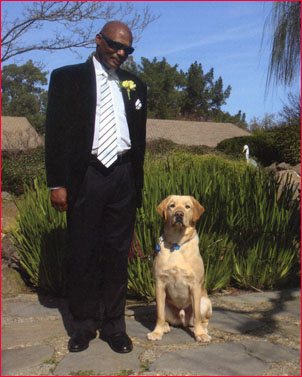| Table Of Contents | ||
HAMLIN BY JAMES SCHARFEN |
||
 |
||
Ken and Hamlin on Hamlin's graduation day |
||
| I wake up to a stench permeating the room. Crinkling my nose, I groggily check the clock. It is two in the morning. I roll out of bed to face Hamlin, a two month old yellow lab I am training as a guide dog for the blind. Catching sight of me, he rushes forward through his mess in an uncontrolled frenzy of puppy energy. I groan and resign myself to the fact that I will be cleaning not only the kennel, but also the dog. I clean him up, and we go back to bed, only to wake up at 5:00 a.m. for water polo practice. I received the first of three guide dogs when I was fourteen years old. Our first day together, Hamlin relieved in the house, chewed a slipper, and chased the cat. Then began two months of diarrhea, my introduction to responsibility for another living creature. I met with my Guide Dog group weekly. Hamlin learned to relieve only on command, heel on leash, tuck under a table in a restaurant, and sit quietly through classes at school. Before I knew it, Hamlin was a year and a half old and it was time for his return to Guide Dogs . Hamlin had grown into a dignified majestic dog, with a big head, massive chest, and a swagger. We nicknamed him “The Jock.” Six months after returning Hamlin to Guide Dogs, I received news that he would be graduating with his blind partner, Ken, having gone through intensive training. Ken was a young African American from San Diego, who had been a football coach before retinitis pigmentosa left him with vision that continued to deteriorate. He teased everyone else in his class by insisting he had the best looking dog. By nature jovial, Ken became solemn when he spoke of not fearing his eventual, total blindness. He said that he and Hamlin were ready. I watched with awe, the commitment that Hamlin showed Ken. He was a dog who completely understood his mission. He watched every move that Ken made, anticipated every step, and his total attention was devoted to his partner. Eighteen months later, I received a phone call. Ken was crying. Hamlin had seized and suddenly died. Ken was apologizing over and over because he couldn’t afford the $1000 to cremate Hamlin and bring his ashes home. He said he would make a memorial to Hamlin, with his collar and toys. Ken was now without a companion who gave him confidence to face the world. His isolation deeply troubled me. What makes life tolerable and how do we bear sorrow? Only through commitment to care for others can we sustain our humanity and our hope. I can’t bring Hamlin back or undo the sorrow Ken feels but I can keep in touch with him and attend the graduation when he receives a new guide dog. I can put all my heart into raising my third guide dog for the blind. -- |